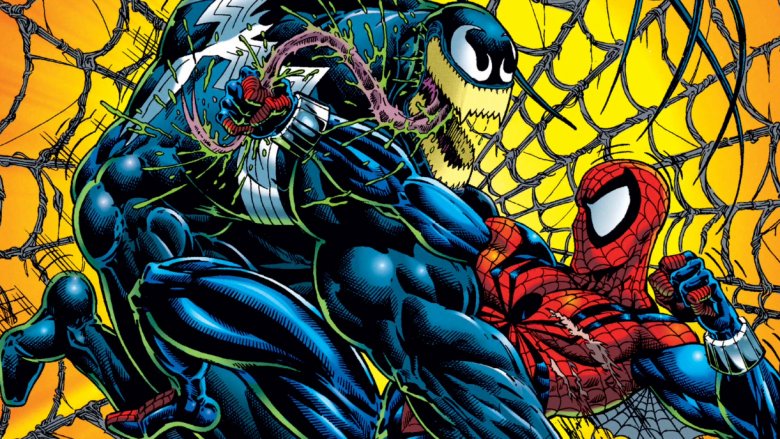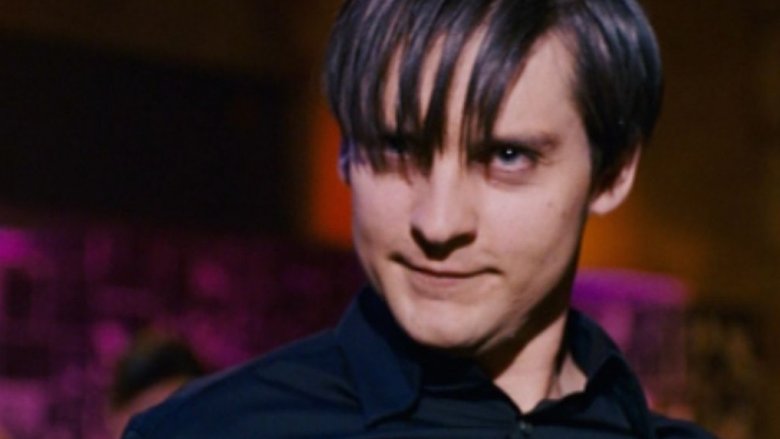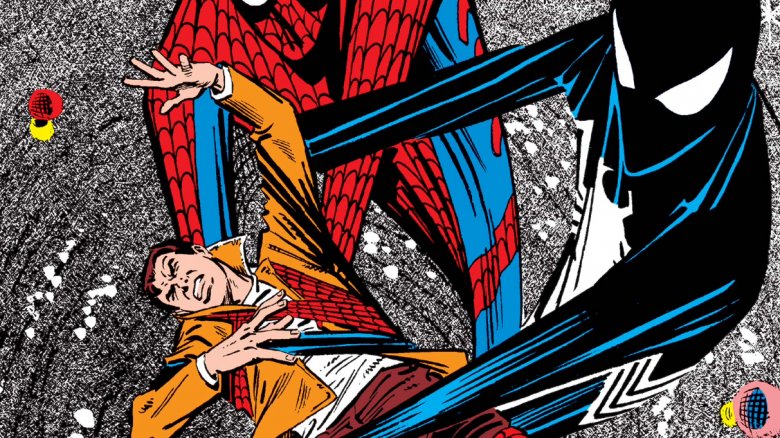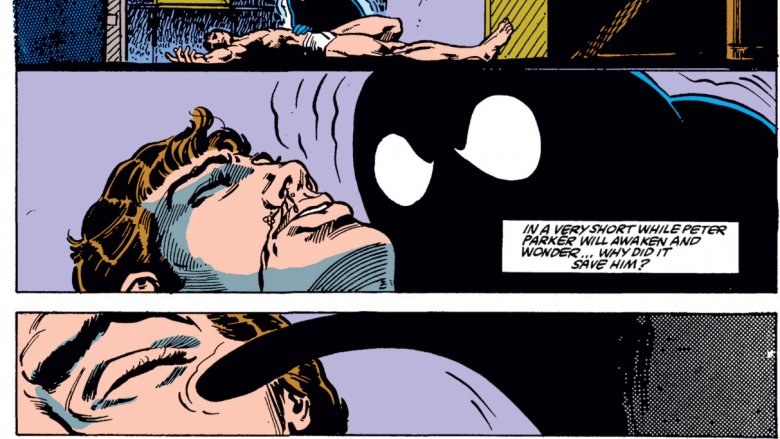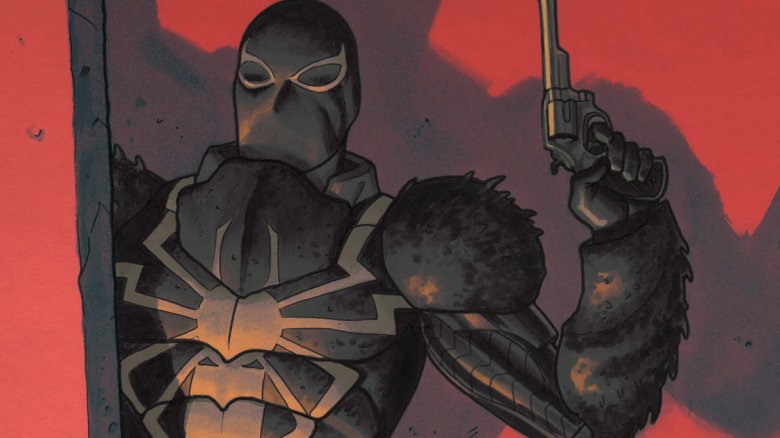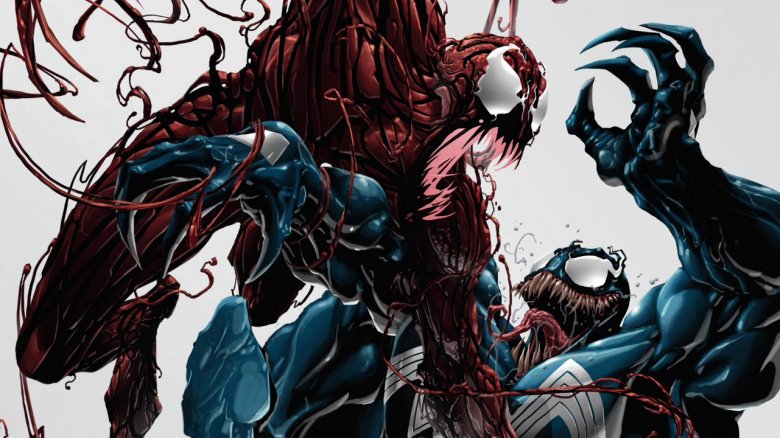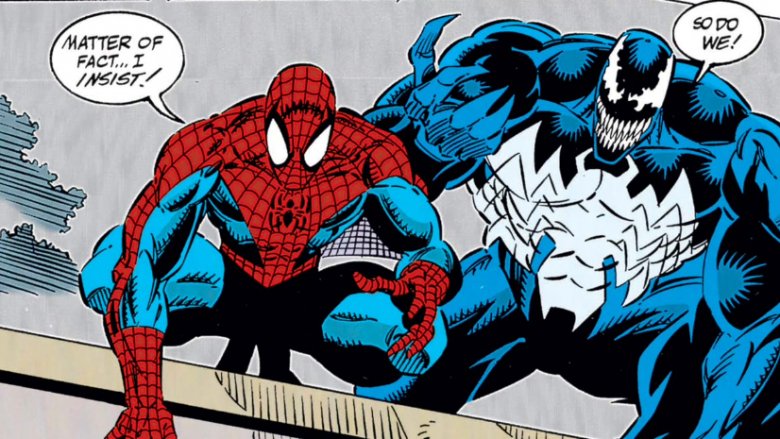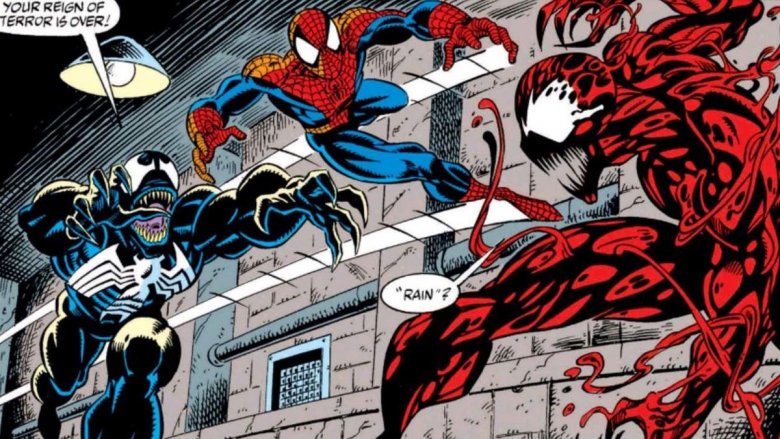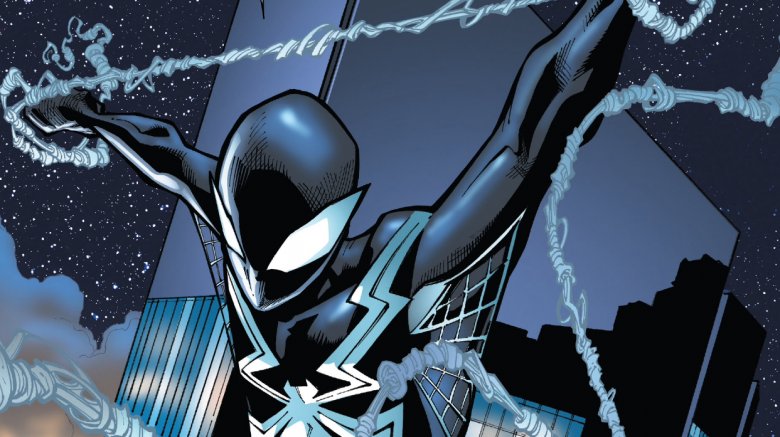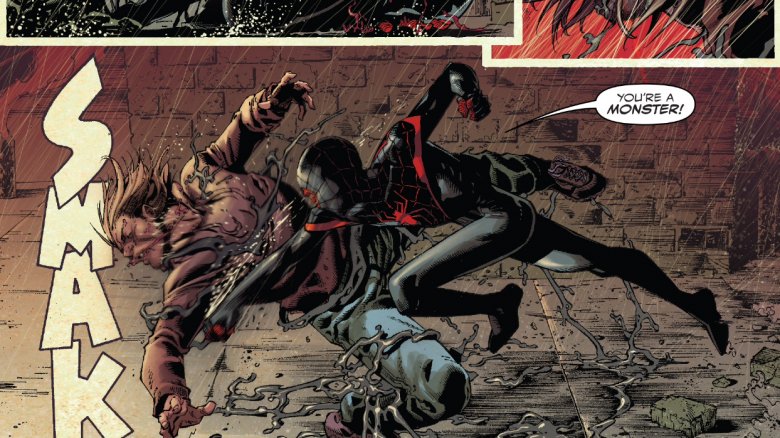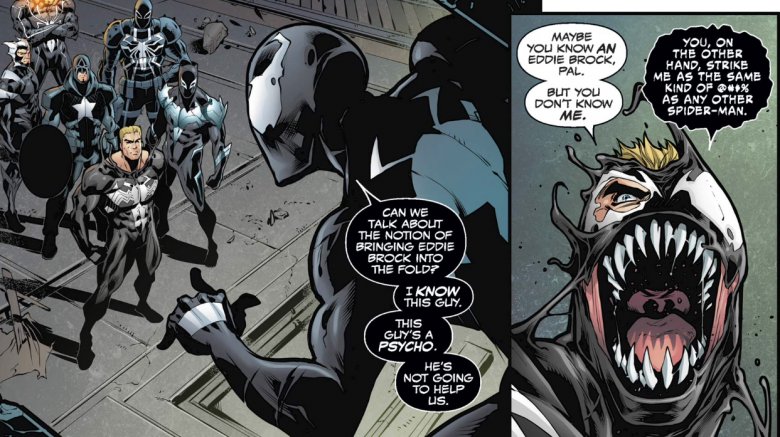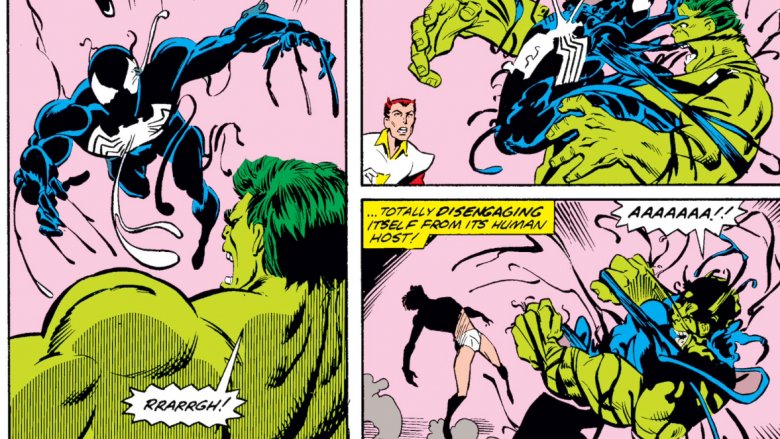Bizarre Things About Spider-Man And Venom's Relationship That No One Talks About
The relationship between Spider-Man and Venom is unique, and a lot of that is because of the nature of Venom's origin. In the comics, Venom is the merging of a man named Eddie Brock with an alien symbiote from a race called the Klyntar. But the Klyntar half was bonded with Peter Parker long before Brock.
Spider-Man comes in contact with the symbiote in 1984's Secret Wars #8 while trying to use an alien machine to repair his costume. Some time after returning to Earth Spidey, with the Fantastic Four's help, gets rid of the symbiote and it eventually finds its way to the more cooperative Eddie Brock. But while the symbiote has been bonded with Brock for longer than it was with Parker — and has other hosts in the interim — it remains fixated on Spider-Man in a lot of ways.
Venom and Spider-Man have been fierce enemies — but while Venom was initially set upon getting revenge on Spidey, the emergence of Carnage and other symbiote threats have forced Spider-Man and Venom into uneasy alliances. The two have a long, complicated history and every time they meet it's always a coin toss to see how they're going to react. Will they fight? Will they work together? Or, as Star-Lord might say, "a little bit of both"?
Keep reading to learn more about the bizarre relationship between Spider-Man and Venom.
The Dark Passenger
In 2007's Spider-Man 3, Peter Parker's (Toby Maguire) bonding with the Klyntar symbiote does more than change the color of his costume and enhance his powers — it makes him a jerk. The symbiote boosts destructive emotions in Peter, like anger and jealousy. Among others things, he hunts and attempts to kill Sandman (Thomas Haden Church), brings Gwen Stacy (Bryce Dallas Howard) to a nightclub in hopes of making Mary Jane (Kirsten Dunst) jealous, and gets in a fight with the club bouncers, which ends with him accidentally hurting Mary Jane. It's this last act that makes Parker realize what's happening and finally take action to get rid of the symbiote.
Things worked out differently in the comics. While the symbiote made Parker do things against his will, it didn't do so by turning him into "Evil Parker." Shortly after Parker returns to Earth with his new suit, the symbiote apparently decides its host is a little too lazy. Most nights the symbiote waits until Parker has fallen asleep, takes over his body, and goes out to find more crime to fight, all the while controlling Parker's still-sleeping body like a puppet. One of the first clues Parker has that something is wrong is when he constantly wakes up exhausted even though, as far as he knows, he's been asleep in bed for hours.
Breaking up is hard to do
While the symbiote doesn't turn Peter Parker into a jerk in the comics, it's clear it impacts his mental state in other, more subtle ways. We know this because of how long it takes Parker to make investigating the suit a priority. It produces its own webbing, Parker can summon and dismiss the suit at will, and he can even make it look like completely normal civilian clothing.
Parker first bonds with the symbiote in Secret Wars #8 and that miniseries lasts four more issues. Parker returns to Earth in Amazing Spider-Man #252 and doesn't approach scientific genius Reed Richards to help him investigate the nature of the suit until Amazing Spider-Man #258. So for the equivalent of a year's worth of comics, Parker simply accepts the fact that he's wearing a freaky magical alien suit he doesn't know anything about. Clearly, the Klyntar is messing with his head.
You could argue that during Secret Wars things are desperate for Peter and the other heroes, and he doesn't have a lot of time to ask questions about something that's boosting his chances of survival. But once he returns to Earth, Peter should make investigating the suit his first priority. It's easy to forget sometimes that Spider-Man is as much a scientist as Reed Richards or Tony Stark. The only sane explanation for his negligence is the symbiote is affecting his mind, forcing him to ignore what he shouldn't.
The one that got away
In 1985's Web of Spider-Man #1, the symbiote betrays the emotional connection developing between it and Parker by revealing an uncharacteristic quality for the alien — compassion.
While Parker is slipping on his classic red-and-blue Spidey suit in his apartment, the symbiote — having escaped the Baxter Building — returns and attempts to bond with Parker. Parker tries to return to the Baxter Building for Reed Richards' help, but the symbiote does everything it can to keep him away from the building. In the meantime Parker is attacked by crooks with mechanical wings, thinking he's threatening their plans. Parker makes his way to a cathedral whose ringing bells hurt the symbiote, who is vulnerable to sound. Parker falls unconscious in the process. The scene is the inspiration for the scene in 2007's Spider-Man 3 when that film's Peter Parker uses a clanging church bell to separate himself from the symbiote.
The symbiote hurries to escape the bells, but returns to save Peter from the thunderous sound. The narration tells us that on its homeworld, the Venom symbiote was emotionless, but its bond with Parker caused it to experience emotion for the first time. Before disappearing, we see the alien reach out, caressing Parker's cheek.
Never leaving his circle
In spite of the Venom symbiote bonding with over a dozen other characters since leaving Peter Parker, two behaviors betray its continued fixation on Spider-Man.
First, there's its tendency to bond with people in Parker's social and/or professional circles. Brock is the first and most obvious example. He's a rival photographer at the Daily Bugle when he merges with Venom. Other hosts include Mac Gargan, better known as the Spidey villain the Scorpion, who bonded with the symbiote as part of Normon Osborn's Dark Avengers. It bonds with Parker's body but Otto Octavius' mind in the pages of Superior Spider-Man — when the vllain better known as Doctor Octopus has transferred his consciousness into Parker's body. Next to Brock, the man to have stayed with the symbiote for the longest amount of time was Peter Parker's former bully and best friend — as well as Spider-Man's biggest fan — Flash Thompson.
What's equally telling is how Venom manifests visually. The symbiote has the ability to mimic any set of clothing. Regardless, no matter who the host is or where they fall on the moral spectrum, Venom continues to base its appearance on Spider-Man's. The eyes of its mask and the spider emblem on its chest might have their roots in the symbiote culture on Venom's home planet of Klyntar, but they're also clearly mirrors of Spider-Man's outfit, as is the fact that it continues to produce webbing even though this is something other symbiotes don't do as a rule.
Spider-Man > Family
At times, Spider-Man and Venom are forced to work together. More often than not, if Parker and Brock are on the same team it's because one of Venom's own spawn is misbehaving — like the insane and powerful villain Carnage. Venom and Spidey famously teamed up — along with other Marvel heroes — against Carnage in the 1993 event Maximum Carnage. There have been other alliances against the more villainous symbiote, and there's bound to be another one in 2019 with the event Absolute Carnage.
Physically, Carnage is more powerful than Spider-Man and Venom combined. Among other things, the villain has survived being beheaded as well as being dragged into space by the Sentry, ripped in half, and left floating in Earth's orbit. Carnage's power and murderous tendencies are fueled by his host Cletus Kasady, a serial killer and Eddie Brock's former prison cellmate.
The Klyntar clearly don't have the same warm, fuzzy feelings the rest of us have towards family. The fact that they were all, on their homeworld, under the direct control of the dark god Knull probably has something to do with that. Still, it's telling in regards to Venom's complicated relationship with Spider-Man that when needing to choose between siding with Parker or with his own spawn, Venom stays on Team Spidey.
Venom gets a pass
It's clear the Venom symbiote has complicated feelings towards Parker, and it seems like those complex feelings are shared.
Spider-Man and Venom have circled each other — in terms of real-world publication dates — for decades. Whether the symbiote is bonded to Eddie Brock or someone else, Venom's place on Marvel's moral spectrum is always cycling between anti-hero and villain. He can spend time as a less forgiving crimefighter — as he did in the 1993 miniseries Venom: Lethal Protector — and next thing you know he's eating people for fun again, as he did in his 2003 ongoing series.
Regardless, as far as Spider-Man is concerned, Venom continues to get a pass. In spite of his unpredictability and his shifting loyalties, Spider-Man never gets proactive about shutting down Venom for good. He's seen him as a hero, yes, but he's also seen Venom as one of the worst kinds of villains. From Parker's point of view, it would seem to make the most sense to actively pursue Venom to try at least to get him back in prison. Yet whether it's Flash Thompson, Eddie Brock, or anyone else, he gets a free pass from Spidey as long as they don't cross paths while Venom's in a lethal mood. The best explanation for this is, whether he realizes it or not, Parker's temporary bonding with the symbiote left him with an emotional connection to the alien.
Best frenemies
The silly-sounding word "frenemies" arguably fits the Spider-Man/Venom relationship better than — or at least as good as — any other two-person relationship in comics.
Venom and Spider-Man begin as enemies and become allies initially due to the machinations of Carnage, but later to tackle other threats. While Peter Parker and Eddie Brock couldn't really be described as friends, the symbiote spent a long time bonded to one of Parker's closest pals, Flash Thompson. The Thompson Venom was a much more traditionally heroic version of the character, becoming a member of the Thunderbolts, the Guardians of the Galaxy, and even a covert squad of Avengers.
As a result of Venom's unpredictability, it feels near impossible to guess exactly how Spider-Man and Venom will react in any given situation. You just don't know if — when Venom and Spidey cross paths — they'll be allies, enemies, or both. Calling them frenemies is not only fitting, but arguably it's the only word you can use to describe them.
One more brief fling
One of the most historically monumental comic book issues of the Venom symbiote's life is 2018's Amazing Spider-Man #800. The landmark issue features three of the symbiote's hosts (four, if you count Otto Octavius, though he's in a different body). The Klyntar has a reunion with one host while another one tragically dies.
Known as Red Goblin after he bonds with the Carnage symbiote, Norman Osborn hunts Peter Parker's not-so-super friends and family like Aunt May and Mary Jane. Thankfully, he learns that Peter Parker isn't alone. His more superheroic allies — like Venom, Otto Octavius, and Flash Thompson — race to help protect Parker's loved ones and defeat Red Goblin. After helping save Mary Jane from Red Goblin, Brock lends Peter the use of the symbiote to help fight Osborn. Understandably, Parker is hesitant to accept the help, but Mary Jane convinces him it's his best option. For the first time since 1985's Web of Spider-Man #1, Peter Parker bonds with the Klyntar.
The Venom symbiote helps turn the tide and Red Goblin is defeated. Unfortunately, Flash Thompson doesn't survive the battle. Having become the hero Anti-Venom since separating from the Venom symbiote, Thompson helps Spidey fight Red Goblin and dies in his best friend's arms.
Miles
Made more famous by 2018's animated hit Spider-Man: Into the Spider-Verse, Miles Morales of Marvel's Ultimate line — a.k.a. Earth-1610 — is transported to Marvel's prime Earth as a result of the events of 2015's line-wide event Secret Wars. So when Miles runs into Eddie Brock in 2018's Venom #3, it's their first meeting. In spite of the fact that the two weren't enemies back in Miles' home reality, their introduction doesn't go well.
With his symbiote being controlled by the god Knull, Venom comes close to killing Miles. The younger Spider-Man manages to temporarily incapacitate the symbiote and Brock takes over. Eddie thanks Miles and begins explaining what happened, but Miles doesn't give him the chance. Miles ruthlessly attacks Eddie and Venom is forced to fight back.
While Miles has never met Brock before Venom #3, he isn't a stranger to symbiotes. While still on Earth-1610, Miles' life is thrown into disarray by that world's Venom — bonded with Oscorp's Dr. Markus — when in the 2013 story "Venom War" Venom nearly kills Miles' father and his mother dies as a result of the conflict, so Miles' unwillingness to give Eddie the benefit of the doubt is understandable. Miles and Eddie work together until Venom #5, when Eddie leaves Miles without warning. Time will tell what happens next time these two cross paths.
Happy together
In 2017, Venom enjoyed a dimension-hopping adventure full of alternate reality doubles just like Spider-Man did in 2014's Spider-Verse — upon which 2018's Spider-Man: Into the Spider-Verse was loosely based. Venomverse reveals alternate realities in which characters like Captain America, Doctor Strange, and Ghost Rider bonded with the Venom symbiote. Just as Spidey and his doubles did in Spider-Verse, the various Venoms are forced to unite when a race of symbiotes called the Poisons begins hunting them across Marvel's multiverse. Eddie Brock of Marvel's prime Earth-616 is the last of the Venoms to be recruited, and one of the other Venoms isn't happy about it.
It turns out somewhere out there in the multiverse there's an Earth where Peter Parker remained bonded with the Klyntar symbiote. This Spidey-Venom warns the other Venoms "this guy's a psycho" and that bringing him on board will do more harm than good. Considering the Venom army's dwindling numbers, Brock must bother this Parker even more than the Earth-616 one if he wants to kick him off the team, but regardless, he doesn't get the chance. The Poisons attack and the Venom army is forced to scatter, and Brock Venom and Spidey-Venom are forced to work side by side to survive. Unfortunately, we never get to learn if these two could get along, because the Spidey-Venom who objects to Brock is killed and taken over by one of the Poisons at the end of Venomverse #1.
It was only physical
Whatever reality the Spidey-Venom of Venomverse came from, we know it wasn't from 1989's What If? #4. Marvel's various volumes of What If? ask what would have happened if different Marvel events had worked out differently. While What If? #4 poses the same question that seems to produce the Spidey-Venom of Venomverse — "What if the alien had possessed Spider-Man?" — things wind up much worse for everyone, including Spidey and the symbiote.
The Venom symbiote of What If? #4 never develops the same emotional attachment to Peter Parker as the Earth-616 Venom. Instead it leaves Parker, making sure to suck all of the life out of him before it does. Once Parker's life force is spent, the symbiote chooses the Hulk as his next host and he interrupts Hulk/Avengers battle of 1984's Incredible Hulk #300 to bond with the Green Goliath. As he does, Parker's body reveals to have been prematurely aged so that he appears to be an elderly man. He dies not long after. The Avengers pursue the Venom-infected Hulk and the symbiote leaves the Hulk's body for Thor's. The heroes finally incapacitate Venom by getting help from the Inhuman leader Black Bolt, whose sonic scream forces the symbiote from Thor's body and renders it helpless (and destroys Mount Rushmore in the process). Before the assembled heroes can banish the symbiote to another dimension, Black Cat kills it in revenge for Parker's death.
